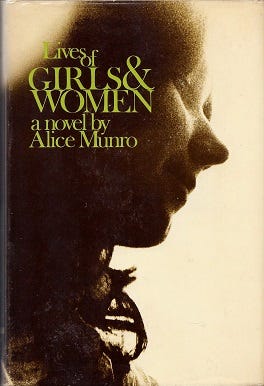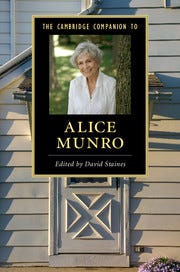Alice Munro
I'll soon be back to the French Revvie with New Atrocities and Scandals for You, but first...
Alice has died, a little short of two months before her 93rd birthday. As her second oldest remaining friend and colleague — Audrey Thomas, author of the excellent Songs my Mother Taught Me among others, is the first, and Jane Urquhart, author of the magic Away, among others, is the third — I have been inundated with requests for “a few sentences,” “a comment,” and so forth. In other words, a sound bite. But Alice does not reduce to a sound bite, so I’m writing this for you, Dear Reader.
I first met Alice through her work. Dance of the Happy Shades came out in 1968, the year after I’d unexpectedly picked up the Governor General’s Award (Canadian, and pretty much the only award at the time) for poetry. I read Alice’s book with great appreciation — I thought “Dance of the Happy Shades” and “The Peace of Utrecht” were particularly brilliant. The Canadian writing scene was very small at that time, so I didn’t think anything of writing to Alice, saying that myself and my then husband, James Polk, were going to be in Victoria, British Columbia — where Alice was living at the time — and that I loved her book and would like to meet her.
She knew who I was, thanks to the GG. She invited us to sleep on her floor — writers were always sleeping on one another’s floors, and on floors in general, in those different times - and so we did.
I have known Alice ever since; that would be fifty-five years. How could that be? Alice would have something to say about it, as one of her perennial subjects was time.
Jump three years. I was now partnered with Graeme Gibson, and was also working with The House of Anansi, a small Canadian publisher. Graeme had interviewed a number of novelists for C.B.C. Radio —for a program called Anthology, headed by Robert Weaver, who had broadcast some of Alice’s first stories. Anansi was doing a book of the interviews, which would include photos of the authors taken by Graeme. (The one of me has a cable-knit sweater I’d knitted; I did two of them, one for Graeme. It amazes me now that I used to churnout such handicrafts.) This was the first such book about Canadian novelists to appear.
The interviews existed on reel-to-reel tape, and Anansi had given them to a stenographer to transcribe, not realizing that she was hard of hearing. It was my task to edit the typescript. What the authors had said was obviously not the same as what was on the page — the best typo was “House of Nazis” for “House of Anansi” — but I did my best, including my best guesses.
I think Graeme’s interview with Alice remains the top one witn her. It’s more relaxed, candid, and unguarded than later intervews. She became wary after she’d become “known” — interviewers could jump out of the shrubbery and try to take you unawares. Alice had a horror of being misquoted, thus appearing to say things she didn’t think. She hated leading questions.
But also, Graeme and Alice were both from SoWestO — South Western Ontario — had gone to the same university — the University of Western Ontario, where they shared some of the same professors — and were of the same generation — she, 1931, he, 1934. They were Depression babies who’d been fully conscious during World War Two, whereas I was somewhat younger (1939). I rememered the war, though not as well, and had not been present during the Depression at all. So they had more in common, in terms of background, than I had with either of them. Graeme used to say that if he hadn’t run off with me, he would have run off with Alice.
The next big book by Alice was the spectacular Lives of Girls and Women (1971). You will enjoy this content warning from Super Summary, I think. Alice certainly would have enjoyed it! She loved to laugh.
“Content Warning: The source text contains references to murder, death by suicide and suicidal ideation, and sexual abuse, including sexual interactions between an adult and a young teenager. The source text also includes outdated and offensive language surrounding race and mental health conditions that are reproduced only via quotations.”
Yep, it was possible to write more frankly and realistically once upon a time. That’s what writers understood as their artistic job. A little suicidal ideation never came amiss. Anyway, what the heck do people think goes on in small towns, and in life in general? And how the heck do they think other people talk when they aren’t makimg public speeches?
Alice always said Lives was a novel, although critics tended to treat it as a linked group of stories. In 2015 — after Alice had won the Nobel (2013) and many of us had realized she was somewhat slipping away, which was why she didn’t attend the ceremony - I was asked to do something for the Cambridge Companion, edited by David Staines. I set myself the task of analyzing Lives as a novel —showing how all the parts of it fit together. (Hint: keep your eye on the Wawanash River.) One of the chapters, “Changes and Ceremonies,” centers around a music teacher who ends by drowning herself, though we first see her directing the high school operettas in the town of Jubilee. Alice names a number of these operettas; names more or less like The Laughing Cavalier in Singing in the Rain. Period-costume romances.
They all sounded real, but when I tried to locate them I couldn’t find them. Phone call to Alice. Me: “Alice, you invented all those operettas, didn’t you?”
Alice (slyly): “Yes. Yes, I did.’
Alice could be quite mischievous, and not only in her writing. Both of us had dark curley hair at one time. We were about the same height.
Alice: “I was standing on a train platform and a man came up to me and said, ‘You’re Margaret Atwood!’” “Yes,” I said, “I am. Then we had quite an interesting conversation about your working methods and where you get your inspiration.”
Turn and turn about: Afte we both had white hair, and after Alice had won the Nobel, people would come up to me and murmur, “Congratulations.” “For what?” “I would say. “You know. Winning that prize.” After a while I stopped trying to explain, and just murmured back, modestly, “Thank you.”
Though the Thank Yous were really for Alice.
(More below the line…)
Keep reading with a 7-day free trial
Subscribe to In the Writing Burrow to keep reading this post and get 7 days of free access to the full post archives.







